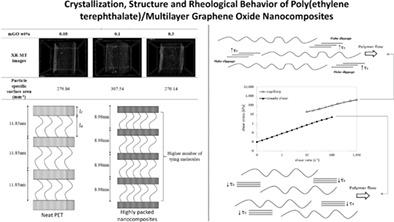当前位置:
X-MOL 学术
›
Polym. Eng. Sci.
›
论文详情
Our official English website, www.x-mol.net, welcomes your
feedback! (Note: you will need to create a separate account there.)
Crystallization kinetics, structure, and rheological behavior of poly(ethylene terephthalate)/multilayer graphene oxide nanocomposites
Polymer Engineering and Science ( IF 3.2 ) Pub Date : 2020-08-28 , DOI: 10.1002/pen.25516 Gabriel M. Pinto 1, 2 , Giovanna da C. Silva 1 , Chiara Santillo 3 , Marino Lavorgna 3 , João M. Maia 2 , Guilhermino J. M. Fechine 1
Polymer Engineering and Science ( IF 3.2 ) Pub Date : 2020-08-28 , DOI: 10.1002/pen.25516 Gabriel M. Pinto 1, 2 , Giovanna da C. Silva 1 , Chiara Santillo 3 , Marino Lavorgna 3 , João M. Maia 2 , Guilhermino J. M. Fechine 1
Affiliation

|
This work aims to produce poly(ethylene terephthalate)/multilayer graphene oxide (mGO) nanocomposites via continuous melt mixing in twin‐screw extrusion, and to study the changes in crystallization and melt flow behavior. Three mGO contents (0.05, 0.1, and 0.3 wt%) were used. Differential scanning calorimetry analyses showed that at 0.1 wt%, mGO acted best as nucleating agent, increasing the crystallization kinetics as well as the melt crystallization temperature (Tmc) by more than 20%. It was also observed that mGO increases the crystals perfection. The nucleating behavior was confirmed by X‐ray diffraction and small angle X‐ray scattering analyses, which showed a decrease in the composites' crystalline lamella thickness (lc) and long period. X‐ray microtomography data confirms that this behavior is significantly affected by the mGO agglomerates distribution and specific surface area inside the polymer matrix. The rheological behavior was studied under two different conditions. It was noticed that under lower shear stresses the mGO particles hinder the polymer flow, increasing the composites viscosity and the pseudo‐solid character. However, under higher shear stresses, for example, when flowing through a die, the nanomaterial enters its “superlubricity state,” acting as a lubricant to the flow. This is industrially interesting, because it may allow the use of less severe processing parameters to produce the nanocomposites.
中文翻译:

聚对苯二甲酸乙二醇酯/多层氧化石墨烯纳米复合材料的结晶动力学,结构和流变行为
这项工作旨在通过在双螺杆挤出中连续熔融混合生产聚对苯二甲酸乙二醇酯/多层氧化石墨烯(mGO)纳米复合材料,并研究结晶和熔体流动行为的变化。使用了三种mGO含量(0.05、0.1和0.3 wt%)。差示扫描量热分析表明,在0.1wt%时,mGO最适合作为成核剂,使结晶动力学以及熔体结晶温度(T mc)提高了20%以上。还观察到,mGO增加了晶体的完整性。X射线衍射和小角度X射线散射分析证实了成核行为,这表明复合材料的结晶薄层厚度减小了(l c)和长期。X射线显微照片数据证实,该行为受到聚合物基质内部mGO附聚物分布和比表面积的显着影响。在两种不同条件下研究了流变行为。注意到在较低的剪应力下,mGO颗粒阻碍了聚合物的流动,从而增加了复合材料的粘度和假固相特性。然而,在较高的剪切应力下,例如,当流经模具时,纳米材料进入其“超润滑状态”,充当流动的润滑剂。这在工业上是有趣的,因为它可以允许使用不太严格的加工参数来生产纳米复合材料。
更新日期:2020-08-28
中文翻译:

聚对苯二甲酸乙二醇酯/多层氧化石墨烯纳米复合材料的结晶动力学,结构和流变行为
这项工作旨在通过在双螺杆挤出中连续熔融混合生产聚对苯二甲酸乙二醇酯/多层氧化石墨烯(mGO)纳米复合材料,并研究结晶和熔体流动行为的变化。使用了三种mGO含量(0.05、0.1和0.3 wt%)。差示扫描量热分析表明,在0.1wt%时,mGO最适合作为成核剂,使结晶动力学以及熔体结晶温度(T mc)提高了20%以上。还观察到,mGO增加了晶体的完整性。X射线衍射和小角度X射线散射分析证实了成核行为,这表明复合材料的结晶薄层厚度减小了(l c)和长期。X射线显微照片数据证实,该行为受到聚合物基质内部mGO附聚物分布和比表面积的显着影响。在两种不同条件下研究了流变行为。注意到在较低的剪应力下,mGO颗粒阻碍了聚合物的流动,从而增加了复合材料的粘度和假固相特性。然而,在较高的剪切应力下,例如,当流经模具时,纳米材料进入其“超润滑状态”,充当流动的润滑剂。这在工业上是有趣的,因为它可以允许使用不太严格的加工参数来生产纳米复合材料。











































 京公网安备 11010802027423号
京公网安备 11010802027423号